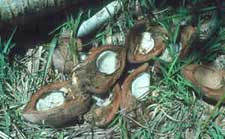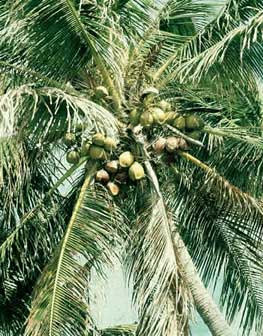 Coconut flowers close up Coconut flowers close up
|
Description: The coconut palm is a long-living plant that reaches heights of 25 m (80 ft). The palm fronds grow to lengths of 4-5.5 m (12-ft). The flowering stalk is usually about 2 m (6-7 ft) long, and the nuts are covered with a fibrous husk that contains an oily endosperm ("coconut meat").

Coconut fruit insides
Distribution: Ni is a widespread tropical plant. Early Micronesian settlers introduced the coconut palm to the Marshall Islands. The Marshallese dictionary lists 11 varieties of coconut: ni bōn, ni būrōrō, ni iaļo, ni kadu, ni lourō, ni lōklōk, ni maro, ni mir, ni mouj, ni mōl, and ni ram.
|
Uses: Ni probably has more applications than any other plant in the world. About 300 different modern and traditional uses have been recorded for this cultivated palm. Marshallese sometimes use the main stems (trunks) of ni as temporary poles in construction. The leaves are used for baskets, handicrafts, and other woven implements for everyday use. Ni leaves are also used as house thatch, to cover the stone oven (um), for shading young plants, and for torches at night. The fruit of ni is a major commercial product. In recent years, because of the low price of copra (dried coconut meat) on the world market, the meat is more commonly used to feed pigs. The Republic of the Marshall Islands government now subsidizes copra production, partly to provide a source of cash for the outer atolls and to discourage further urbanization. Grated coconut meat is still an important cooking ingredient, especially with fish, breadfruit, and various root crops. Grated coconut meat or juice is also mixed into many medicinal
preparations. Coconut oil, used for various cosmetic and other purposes, is often scented with various sweet smelling flowers, or both flowers and the powder of lit, a fungus that grows on the coconut trunk. Young nuts are gathered, and even sold in some places, for the popular coconut juice drink. Another drink, jekaro (known elsewhere in the Pacific as toddy or tuba), is the sweet sap extracted from the flowering stalk of ni. Jekaro is used in a variety of ways: as a sweet drink while still fresh, as a mild intoxicant or as a leavening agent for bread baking after the sap has fermented a day or two, and as a strong liquor when distilled. The unfermented sap may be boiled down into a sweet molasses (jekmai), or a candy-like sugar (jelinan) not unlike maple sugar in taste and consistency. The heart of the palm (jiap), a cabbage-like substance, is occasionally used for food but, since it necessitates the felling of a tree, its use is usually restricted to special occasions. The coconut shells are used as cups, as a source of charcoal for cooking and in modern days for jewelry making and other decorative crafts. Sennit rope, or twine, is made from fibers in the mature husks. There are numerous other uses for ni in the Marshall Islands, including some medicinal applications. The husk of ni maro, a variety with a blue-green nut, is squeezed in water used for babies' baths. Such baths are also good for adults to tone skin. Coconut leaves are used to channel a mixture of very hot water and coconut oil to irrigate the birth canal without scalding the skin. Ni trees with slashes cut in their trunks mark land boundaries. Although it no longer retains its former role in the commercial agricultural economy of the Marshall Islands, ni remains a very significant plant in the Islands' culture. |

|

